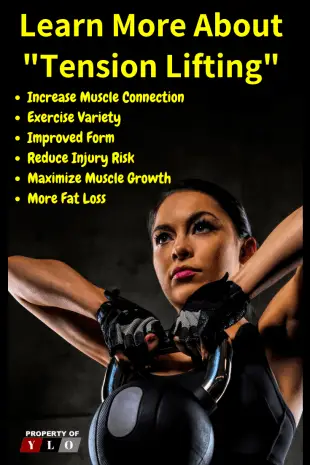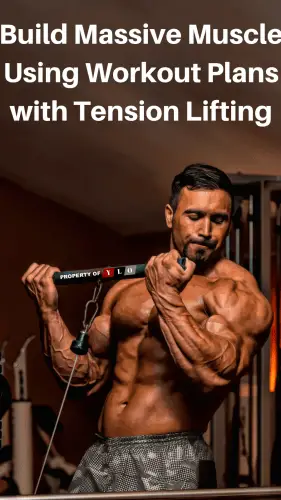Adding Tension Lifting to your workouts will get you moving again if you have reached a troublesome plateau in your exercise routines & weight loss efforts. It can be frustrating when you are working out and eating properly but results are still not what you were hoping for.
In The Beginning
Indeed, weight loss can be easier at first when your body is not accustomed to exercise but as you get more fit weight loss can be more challenging. We’ve all been there, feeling stuck and hopeless about the time we’ve spent in the gym working on the treadmill.
Nutrition, genetics, and unique body characteristics make a difference in your fitness routine and the results of your work. There are exercises and styles that can produce amazing results for anyone.
Exercise and fitness is a complex science. Weightlifting can revolutionize your workout routine. However, I was afraid to try any kind of weight training because I was worried about bulking up and getting bigger.
For that reason, I stuck to cardio at the gym and stopped losing weight. Finally, I tried lifting some weights and working with some of the strength-training machines during my gym visits.
Almost instantly my body just started dropping fat I had desperately been trying to lose. I know this sounds too good to be true, but here’s how it works.
Tension Lifting Changes How Your Body Reacts
Weight training, with tension lifting, is an often overlooked opportunity to change how your body is burning fat and building muscle.
Tension lifting and its twin, relaxation, are the foundations of strength and conditioning. The trouble with tension, like other weight lifting techniques, is that it can be difficult to recognize when you’re in the zone and focused on training.
I believe that the gym is a great place to workout and keep yourself disciplined. It can also be a distracting place and you might not always be mentally aware of how your body is responding to certain exercises and training.

Lifting Techniques Need to be Learned
Before you can properly focus on tension and tension lifting, there are a lot of lifting techniques that need to be learned first. Keeping your buttcheeks squeezed together, abs firmly braced, and keeping your lats pulled back are all techniques needed to properly lift and strength train.
Together, these techniques take time to master and can delay someone trying to jump in and become a strong tension lifting user. For people trying to change up their fitness routine, it can be a challenge to get over the basic techniques in order to properly perform pieces of training and lifts.
Here’s why you’ll want to take a little bit of time to master the tension lifting technique and how it can make your workout more effective.
Techniques Prevent Injury
Tension lifting can help you fix bad biomechanics and reduce the likelihood of injury What a lot of people call ‘lack of mobility’ or ‘lack of flexibility’ is really lack of stability.
Let’s say you’re having trouble staying upright when you are squatting. Your torso is leaning forward as you descend.
This is really a balance issue related to the strength of your core muscles. You are not stable enough in your midsection to descend deeper into the squat.
This can be corrected through correctly learning tension lifting. Learning to create more tension in your core can help you with these “mobility” issues.

Kinetic Chain and Energy Leaks
If you’re an experienced lifter, this may be a little familiar to you. You may also be familiar with the terms “kinetic chain” and “energy leaks”.
The kinetic chain refers to the body’s joints, or anywhere your body bends. The joints must work together for movements and especially for lifts.
Energy leaks occur when there is a lot of tension surrounding one of those joints. Imagine that you’re doing a back squat and your knee caves frontward.
That is a sign of an energy leak. This is a problem because it places a lot of strain on the joint which can damage the area and it causes muscle imbalance.
Imbalance Means Non-Targeted Muscles Have To Pick Up The Slack
Whenever you experience an imbalance, other muscle groups that you are not specifically targeting have to help you make up the energy difference. It may not be much of a problem during lighter weight exercises and training but as you increase the weight you are using, the risk for severe injury and damage increases.
When you think about weightlifting technique, you may only think about the specific muscle group that you’re targeting. This is incorrect.
Your Entire Body is Involved in Tension Lifting
Think about your entire body in relation to the training you are performing. Your entire body needs to be prepared for movements or lifts. If you are lifting and don’t make sure your stance wide enough, you are at risk of injuring your back.
Staying with the example of the squat, tension can often be a protective factor. When you get ready to do a squat, you may think about protecting your knees and back.
You should always make sure your stance is appropriate. You want your shoulders straight against the bar to avoid arching your back as you squat.

Focus Your Mind During Workouts
As you prepare, take a deep breath and tense up your body to prepare for the squat. This tension sends a signal to your brain that says “I am ready to lift”.
The tension in your body will help you keep your elbows down and back. This engages muscles that are necessary to protect your spine.
The heavier the weight that you use when lifting, the more aware of your technique you need to be. As you increase your weight, make sure that you have created a proper foundation to prevent damage and injury.
An incorrect technique can lead to permanent damage and injury. That takes you ‘out of the game’, figuratively or literally, when you are lifting incorrectly.
Be Smart
Every rep beyond 5 or 6 becomes increasingly more difficult to do, so you open yourself up to more injury risk. That’s why you should use low reps on the big lifts. It’s really hard to maintain that tension while maintaining good form.
Anyone who has experienced an injury due to poor form will tell you that form is everything. There is nothing more detrimental to your progress and fitness health than an injury taking you out.
Tension lifting isn’t only about safety though. Tension may also reflect what you are getting out of the exercise.
Think about planks or push-ups, the results only start happening after your muscles begin to ache. The best thing you can do for muscle growth makes it ache.
Full-body Tension is Optimal When Building Your Strength.
What do we mean when we say ‘full-body tension lifting’? We mean exactly that: your entire body. If you’re asked to do a plank and you forget to breathe because you’re so tense, that’s when you know you’re doing it right.
The more you push your entire body during a plank, the more you’ll optimize the results that you are getting out of the exercise. You want to push out through your heels and pull your elbows towards your toes when planking.
Mind and Body Together
Focusing on tension during workouts can also improve the mind-body connection during exercise. There is nothing more important than a strong mind while exercising.
If you lack discipline and perseverance, there is little benefit to be had from working out. A strong mind can be the coach you need when trying to advance your fitness to the next level.
Keep it Simple
When adding tension into your workouts for the first time, try to avoid using exercise machines. Rather, take the opportunity and really focus on your body.
Tune-in to how tension lifting changes the way you experience and feel the workout. Keep your attention not on properly using machines but instead focus on creating and maintaining tension throughout your entire body.
Remember to try fewer reps at first while exercising. Give yourself the opportunity to pay attention to your tension techniques and form as well.
Building Your Core
Focusing and building your core is also the next step to advance your workouts. Tension lifting will change the way your abs and hips engage during squats, deadlifts, and overhead presses.
Work on your shoulders as well. When working on your shoulder strength, you may often hear advice like ‘pack the shoulder’, or ‘flatten your shoulder blades’.
All these pieces of advice basically have the same message. In order to keep your arm bones where they belong in their socket, add tension to muscle building exercises.
If you’re performing an exercise that involves you standing, your butt should never be relaxed. Always have your glutes squeezed together in order to support your body and balance.
Think about your feet when building tension. A lot of coaches will tell athletes to ‘screw your feet into the floor’ or to ‘push the floor away from you’.
Whichever instruction you find most helpful, tell yourself that and keep the tension radiating in your feet. It can really make a difference in balance and power during motions and activities.
There Is A Learning Curve to Tension Lifting
Adding tension to any workout is a learning activity. Don’t give up if you’re not seeing the results you want immediately or if you find it extremely difficult.
It’s supposed to be a challenge! But it is a challenge worth overcoming so you can optimize your workout results and prevent injuries from occurring during strength building exercises.
• Get the most motivational workout music you can find and get that tension going!
• As always, be sure to stretch and warm-up your muscles before beginning your workout.
• Tension lifting is supposed to help you prevent injury during workouts and training, not the be the cause of injury.
Lifting and strength building exercises are all about correct form. If you’re just beginning, make sure that you have your form perfected first before you add a bunch of heavier weights into the mix.
Safety is always key because nothing will keep you from being successful in your fitness goals like an injury, sprain, or muscle strain. Tension workouts will give you that edge you are looking for in strength training and athletic performance.
A helpful article by WebMD: Strength Training: Building Shoulder and Back Muscles



